INTRODUCTION
This paper is concerned with the study of Kwamteng. A deity among the Goemai people of Shendam Local Government Area of Plateau State Nigeria. Kwamteng is a traditional secret cult with only male membership and they worship a god called Mat-Karrem although they believe in the existence of the supreme God called Na’an. This cult is said to equip and build young men of between 15-25-years into adulthood or manhood. Simply put, this work is concerned with the investigation and documentation of the activities of Kwamteng which include infant circumcision, certain rituals, warfare, and treatment for certain diseases, social and festive events and spirituality among others.
The aim of this research is to document the history and cultural practices around Kwamteng, with emphasis on the significant roles it plays in Demshin community. This is achieved through the collection and documentation of oral tradition on the history, origin, development, impact as well as the value of Kwamteng as an aspect of the culture history of the Goemai people and to study the material culture involved in the activities of Kwamteng and to document the cultural practices around Kwamteng.1,2
The word Kwamteng in Goemai dialect means the twig of a tree, literally it means the ear of a tree. The ideal meaning of the word is obscure but it is base they believe that the walls have ears. Since the Kwamteng activities are mostly carried out in the bush, they see themselves as the ears of the tree and can hear and see the evil people do in the dark or in secret.
This study is relevant to the culture and tradition of the people of Demshin because it contributes significantly to the rich culture and heritage of the people of Demshin. The people who occupy the study area according to oral tradition are the descendants of Lekni who is also the progenitor of the Goemai people who are located in the southern part of Plateau State.3,4
Geographical Location
The Goemai people predominantly live on the southern plains of the Jos Plateau, they are found within the present day Shendam and Qua’anpan Local Government Area of Plateau State with many of them also indigenously found in Langtang South LGA of the state and some are in Awe LGA of Nasarawa state.5,6,7 They are on the northern part of the Middle-Benue valley which is almost in the geographical center of Nigeria, a location commonly referred to as the Lowland because of its relatively low topography.
The land is generally flat and undulating with rocky outcrops and buttresses here and there. The Goemai geographical area is bordered by Ibi in Taraba state to the south, Qua’anpan LGA to the east, Pankshin LGA to the north and Mikang LGA to the west. Shendam is located on 8°53’ N 9° 32 E. It has an area of 2,477 square kilometer and a population of 208,017 at the 2006 census. The study area is located on the south-western part of Shendam LGA and it is bordered by Angwan Rina to the west, angwan Dadi to the north and Turnyang to the east (Figure 1).
Figure 1. Map of Nigeria Showing the Study Area
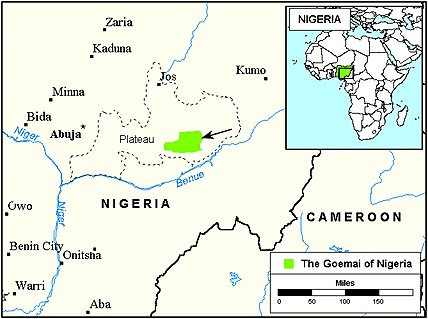
METHODS
In order to achieve the research, set aim and objectives, the following methods were employed in order to get the required information necessary for the purpose of this research:
Written Documents
Written documents relevant to this research were reviewed. This provided the researcher with background information which created the path to follow in order to achieve the set objectives. These written materials were a combination of both published and unpublished works and archival materials sourced from National Library Jos, Plateau State Library, University of Jos library, Department of History and International Studies library, pamphlets published by scholars and researchers alike on the Cultural festival organized by the Goemai Youth Movement. Archival materials were also consulted such as Gazetteers of the Northern provinces of Nigeria and a video documentary.8
These written sources were properly and carefully studied and used alongside oral tradition which helped in providing information that was not collected through oral interview, and these written documents helped in providing the correct spelling of indigenous words and were also used to form the basis for a broad literature review on traditional secret cult on the Jos Plateau and other areas in Nigeria and the world.
Oral Tradition
Oral traditions are messages or set of information stored in the human mind or memory that are being passed through successive generations by the word of mouth. Defined Oral traditions as verbal messages which are reported statements from the past beyond the present generation.
Oral tradition has been useful in archaeological research especially in locating sites, in analyzing and dating of the cultural materials recovered from the site, and for the interpretation of collected data. Despite its usefulness in archaeological investigation, the validity of the use of oral tradition in archaeological investigation has been questioned by scholars. One of the grounds is that people can recite two or more versions of the same tradition and those in the society who hold the tradition can suffer memory loss.9,10 However, with all its shortcomings, oral tradition remains one of the major sources for the reconstruction of African history.
Thus, an oral interview that cut across people of different gender, occupation, social background and age was conducted. This was to enable the researcher acquire information on the people’s origin and migration history and to determine the level at which Kwamteng is popular or known among the people and especially the younger generation. To collect different versions of oral information for better understanding, to ensure gender sensitivity and ascertain gender role particularly on the traditional secret cult. This method provides the researcher with information on the origin and development of the cult, the factors that gave rise to the evolution of the cult. Oral tradition also helped the researcher in the identification and interpretation of the material culture of the cult. This information was audio recorded and some were transcribed on paper.
Furthermore, twenty-five (25) persons were carefully selected for the interview on the basis of their affiliation to Kwamteng and Goemai culture history irrespective of their gender, age, religion and social background. Structured questions which yielded the required information were asked during interview. This guided the researcher to acquire valuable information. Individual interview was employed when necessary to provide a more conducive atmosphere for better interaction. This is because some people are uncomfortable while speaking in public and it also enabled the respondents to freely express their views without fear or favour. However, group interaction or interview was also employed which was of great significance because individuals with better knowledge were able to checkmate and correct mistakes that were made by others during the interview. It also gave room for the younger ones to acquire more knowledge about Kwamteng, their people and culture.
Ethnography
Ethnography is a qualitative methodology that lends itself to the study of the beliefs, social interactions, and behaviors of small societies, involving participation and observation over a period of time, and the interpretation of the data collected.11,12 It is also a systematic and descriptive study of a contemporary or extant culture, people and civilization in order to understand specific and basic aspect of a people’s experiences and culture. Ethnography provides the researcher the opportunity and privilege to interact, participate, witness and observed some of the activities of Kwamteng.13
Using this method, the researcher observed some of the activities of the cult through the material culture of the cult as to gain practical knowledge of the cult activities and for better understanding of the cultural practices around Kwamteng for the purpose of recommending that aspect of Goemai culture for archaeological research. But in situations whereby the researcher could not directly participate, probably during rituals meant only for initiates or members of the cult observational approach and oral interviews were employed.
An Ethnographic Study of Kwamteng in Demshin
Origin and development of the Kwamteng in Demshin: Kwamteng is a Goemai traditional religion practiced among men who worship in the shrine and believe in Mat-karrem deity. Although everything in Goemai culture revolves around the man which makes him to have a very responsible role to play in the Goemai society. Therefore, to be a real man in Goemailand you must be initiated. That brings us to the subject matter, the Kwamteng, which is an institution whose activities are sacred and some of which are secret traditions practiced among members of the cult.14
The history of Kwamteng traditional secret cult pre-dates the knowledge of the informants thus, it is as old as the community itself. However, the history of the cult from oral tradition involves series of transfer of powers and mantle of leadership through successive leaders.
From oral tradition, Kwamteng started from a village called Lukwor a neighboring village where men from Demshin normally go and get initiated into the cult and then return to Demshin and practise their cult activities. At a point in time, people from Demshin started missing mysteriously especially men. This very act resulted to the establishment and installment of Kwamteng from the headquarters in Lukwor down to Demshin. This is because the Kwamteng Cult can give them both physical and spiritual powers that will give them protection over being missing this will happen in a way that when someone with bad intentions wage an attack on them, they won’t see them, because the settlement will turn into a river, desert or a forest.
For this reason, Longpiad who is the progenitor of Kwamteng cult in Demshin with the approval of the chief, Long Akur traveled to the Headquarters at Lukwor to learn this cult which he collected the knowledge and brought it down to Demshin and started initiating people especially men of different age grade, healing sicknesses and diseases which he did it very well-until his death. He was succeeded by Longmas which he also did well and after his death Garkwa succeeded him and died also and then Katunku succeeded him and died then passes it to Danju which he died and handed it over to Nkwap Dongdá which he is currently the leader of the Kwamteng cult in Demshin.
Kwamteng Promises and Claims
i. The cult claims that it is established to cure certain ailments and diseases.
ii. It gives protection from spiritual attacks and as such if they plan evil against a member such a person will overcome it without being harmed.
iii. Established to give protection over death especially when it is from witchcraft and in some cases when a member of the cult has an accident somewhere, he can disappear and reappear back home and continue existing.
iv. When food is poisoned and a member of the cult eats the food unknowingly, he will vomit the food.
Initiation Items or Requirements
Items required for initiation into the cult depends on the numbers of days the recruit want to spend in the jungle which is justified by the reason such a person want to join the cult. The initiation process can last for a day, two days, a week a month or two and even three months. And these items include one chicken and 10litres of local beer (Mmues) mostly for young men who are within the ages of 15-20, two chickens and a gallon of local beer (Mmues) for adults and a big goat and a gallon of local beer (Mmues) for an elderly person.
The Kwamteng Initiation Process
The Kwoi: These are graduates of Goemai leadership and manhood training camp that normally last about three months in the jungle and they are called Kwoi which means infants. The young initiates who go into the jungle as boys and come out as men regardless of age are treated equally. When they initiates are going into the jungle they dance and follow the Long Dorok’s palace from where they head into the Jungle for the training wearing Bantè or tie wrappers. While in camp they are meticulously taught Goemai History and Language, Goemai geography and its neighbors, the spirit world, divination, kinship, genealogy, medicine, ritual and warfare. They are also taught the Goemai habitat and religion, style and fashion, farming and agricultural seasons, architecture, hunting, craft, civility, marriage norms from courtship to procreation, taboos and in the creative arts music and dance steps. While in camp, they Kwoi do not bathe and neither do they allow water touch them because it is believed that once water touches them, especially rainfall they will all transcend into the spirit world which literarily entails that they will all die in the camp. The Kwoi cook and eat in the camp of which their food are basically, grains and food without any form of fresh vegetables, without pepper and oil. Their kind of food is however locally called Gwom. While in camp, the initiates are from time to time sneaked into the village at midnight when everyone in the village is asleep to walk round the village making a particular sound peculiar to them. This was done to tell their family members about their well-being in the camp and to ensure to the entire community about their safety.
After the three months training in camp, the initiates or Kwoi are being celebrated in the village square. They disguise themselves beyond recognition where they use mud mixed with ash and rub all over their body and face and they use Bante to cover their private parts and leaves to cover their face much better as they dance rhythmically to the music. They move in a straight line as they dance from the jungle to the village square. The members of the community are not allowed to come close to them especially men who are not members of the cult, they stay from a distance and watch this is to show respect. Members of the cult who are close to the Kwoi as they dance into the village square will have to remove their shirt instantly. However, women are allowed to have a closer look at the Kwoi during this celebration. When this is not done, the initiates will quickly grab any audience who is not a member of the cult, and even a member who did not remove his shirt as sign of respect and injure that person using their bare hands and finger nails. After the celebration, the Kwoi will therefore move to the Ludas and reside there for a few days as they move from house to house to dance and they will be issued with food items such as salt, dry fish, Dadawa, Gauta, dry Karkashi, dry okro and grains which they use in making their food in the Ludas. During their stay in the Ludas they are not allowed to speak or talk to anyone in the community especially those who are not members of the cult. i.e. they are only allowed to speak to their contemporaries or fellow Kwoi. At the end of their stay in the Ludas, they are taken to the river and their hair shaved.
This mark the end of the initiation process and the shaving of their hair serves as an identification mark of the members of the Kwamteng in the society and as such, the society is expected to give them the respect they can get for being a member of the cult and as such they are henceforth called Yaran Allah which is in the Hausa language. For the period of their reign and when the Kwoi is passing women making hair are expected to acknowledge the Kwoi presence by saying ‘Gafara’ which means excuse in English and the Kwoi will pass quietly and freely. But if the women do not acknowledge the Kwoi he will pass the second time and if they still keep quiet he will pass the third time after which he will just remove his clothes and then fall down there and begin to cry, and his fellow initiates who see him crying shall do same. This shall continue until a Miskoom intervene by asking for explanation from the Kwoi then the elder shall pass his judgment, if the ladies are found guilty of the offence of not acknowledging the presence of the Kwoi. The ladies shall be asked to pay a fine in form of a chicken and a gallon of local beer (Mmues) from the day of the incidence to the next day and if the ladies stubbornly fail to provide such items, the Kwoi shall come with an object that looks like a rope made from plants or tree bark from the shrine and then tie the rope round the girl waist and then remove the rope. This very act will lead to the mysterious death of the lady in a short while. This very act of removing shirt and crying is also applicable to people who are fighting in the community. The Kwoi will come and ask the fighters to stop fighting and if the fighters prove adamant and continue fighting the Kwoi will then remove his shirt and start crying until an elder intervenes and passes his judgment (Plate 1).
Plate 1. New Initiates Going into the Recruitment Field
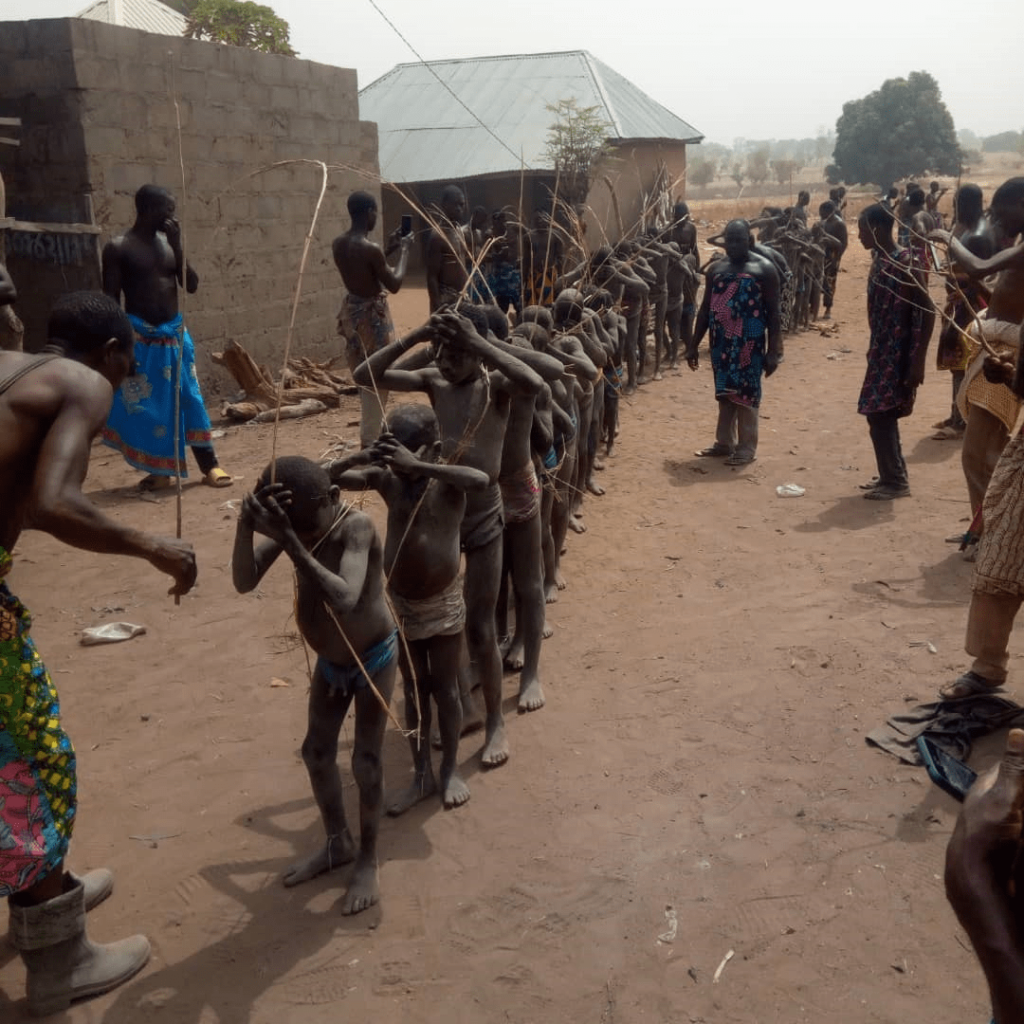
Burial Rites of a Deceased Member
Prior to the death of a member who violate any oath he took in the shrine the consequences of such oath is mostly dead and when this start manifesting through severe ailments the chief priests will come with a chicken and then say some enchantment so as to evoke the spirit of the person into the chicken so as to force the person to confess all his evil deeds before his death.
Upon the death of a member of the cult, all the Kwamteng members shall assemble in their attire of tying a wrapper on the waist without shirt and match to the deceased compound to bury him. Several forms of rituals are being carried out on the deceased grave yard before they bury the deceased. These rituals according to them, has to be carried out in fulfillment of the burial rite of the deceased which involves incantations and the purpose for these burial rites and rituals is not disclosed to the researcher.
A Survey of Natural and Cultural Resources involved in Kwamteng
The Nmai: This is the jungle that is reserved to serve the purpose of the recruitment ground or field for the Kwamteng initiation as well as training. It is also the place the cult takes her members or non-members who are sick to treat them. It is located at the outskirt of the village; the Nmai is located between the area of study and Angwan Rina which is the neighboring village. This jungle is very large and it is about three hectares of land with a variety of species of grasses and trees. Due to the sacred nature of the field, there is no form of human encroachment into the site and as such, human activities around the site is minimal. For the Kwoi during recruitment, the settled in the bush for the period of their training exercise (Plate 2).
Plate 2. Nmai (Recruitment Field of the Cult)
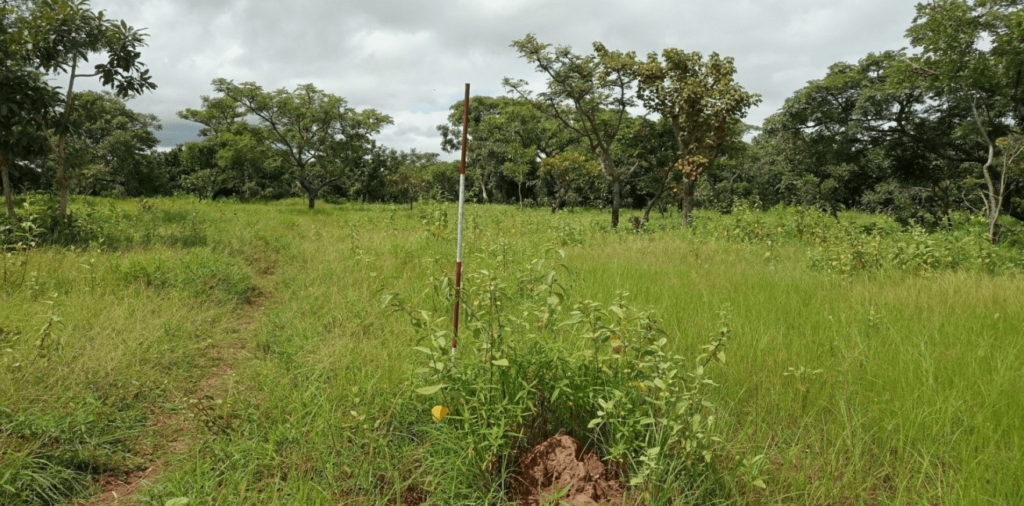
Ludas: This is a sacred room or house that only men are allowed to go in, it is a place where some certain rituals are carried out. In the case of Kwamteng, the Ludas is where the Kwoi or new initiates stay for the period of five days to one week immediately after graduation from the leadership camp or jungle. they stay here in partial fulfillment of their recruitment process and from time to time they go out into the community and dance in people’s houses and in return the host houses will offer them grains such as maize (Zea mays), guinea corn (sorghum bicolor) or millet (pennisetum glaucum), dry fish, dadawa, salt, dry okro, dry karkashi and even dry gauta which they will take back to the Ludas where they can use the items to prepare their special delicacy called Gwom. The Ludas also serves as a store house for keeping Kwamteng musical instrument and even some ritual equipment such as Tu Kwamteng, Shair Kwamteng among others (Plate 3).
Plate 3. Ludas (Mens House)
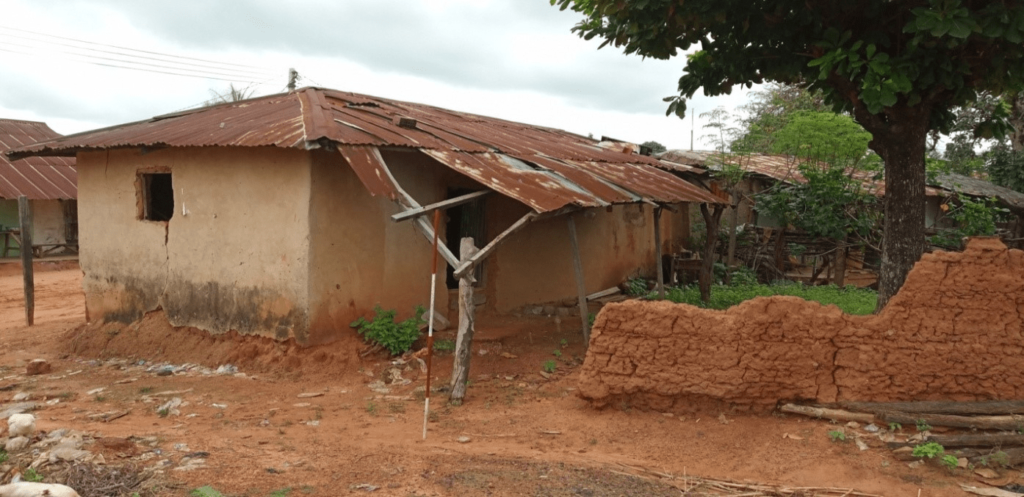
White Chicken Feathers: Traces of feathers identified to be a chicken feather was discovered in the field, these feathers are such that they suggest a slaughtered chicken used for rituals and then consumed by the Kwoi. This is because the feathers evidence is found in close proximity of 1 m from a hearth (Plate 4).
Plate 4. White Chicken Feathers
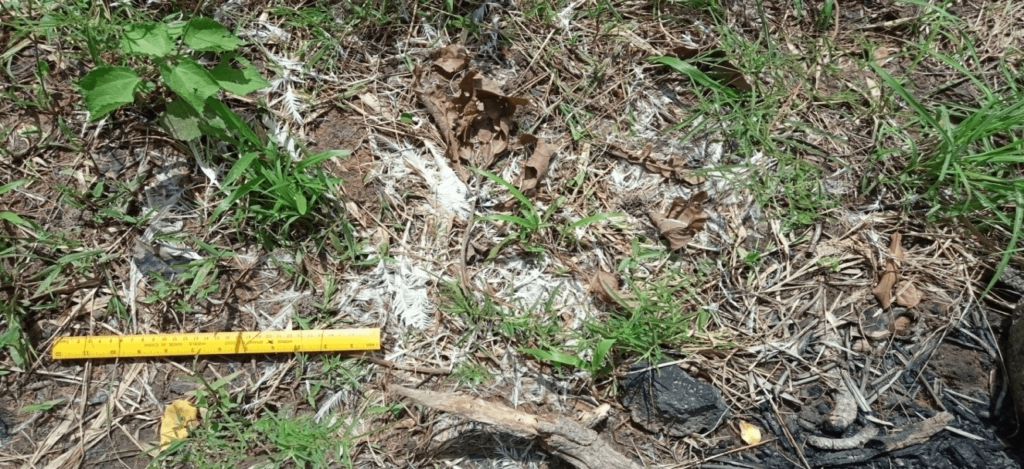
Hearth: This is a fire place located in the Nmai, jungle or recruitment camp. This fire place is where rituals associated with the use of fire is being carried out and even cooking of the Kwamteng food is done firewood is obtained from the jungle. They use a clay pot to cook and then a big calabash to dish out the food before it is shared. This fire place is located at the centre of the jungle and there are speck of charcoal, remains of burnt firewood, traces of ash and even evidence of feathers and pottery vessels some of which are partly destroyed close to the hearth (Plate 5).
Plate 5. Hearth
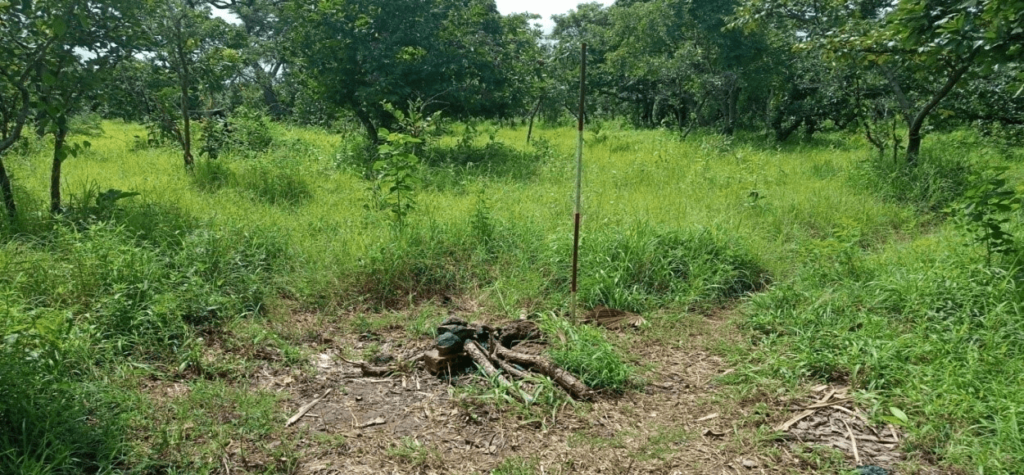
Kong: This is a river located at the eastern part of the village. It is a place where the Kwoi are being taken to after the celebration at the village square. They move to the Kong to go and wash the mud on their body, perform some rituals and then cut their hair as part of the initiation process from where they shall be taken to the Ludas where they will stay for the period of a week or two (Plate 6).
Plate 6. Kong (A River)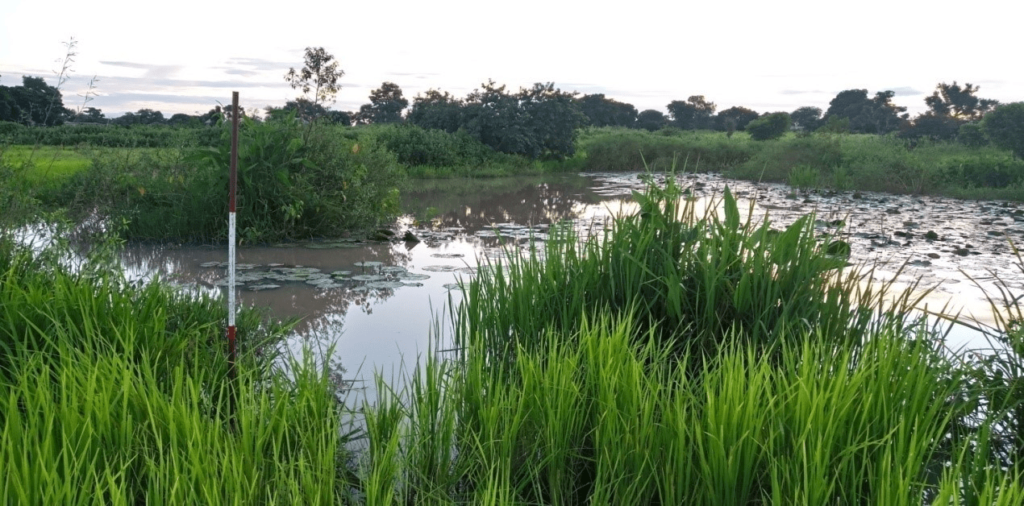
Shair Kwamteng: The Shair Kwamteng is a calabash cut in half with perforated decorations and canarium seed (Canarium schweinfurthii) being tied to pass through the perforated holes. It is a musical instrument used to produce sounds that are accompanied with the song and music of the Kwamteng cult to dance during festive events, celebrations as well as matching into the Nmai or jungle. It is also used to produce sounds during rituals in the shrine especially when the rituals incantations and enchantment involve the use of music. The instrument is being played with two hands and sometimes the person playing it can decide to dance while playing the instrument (Plate 7).
Plate 7. Shair Kwamteng
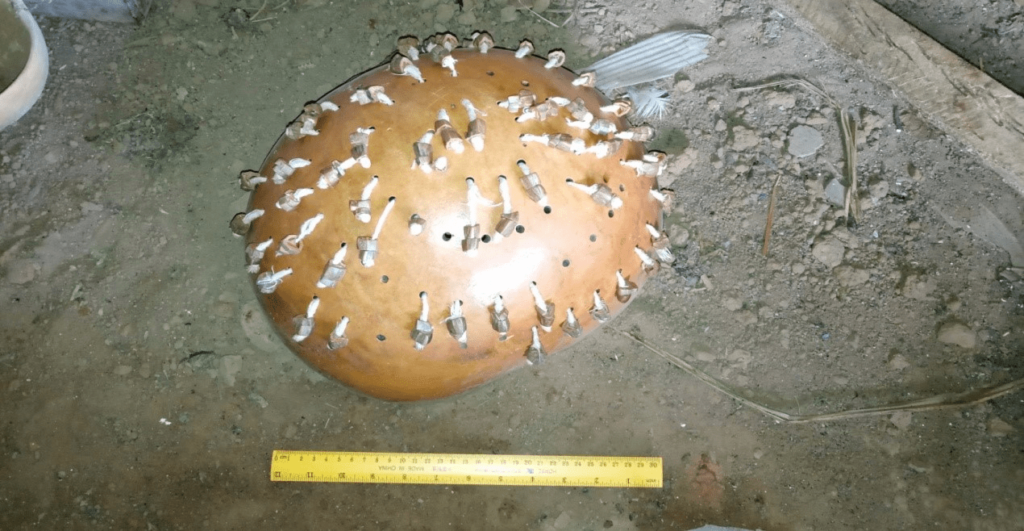
Won Ntuluwa: This is identified to be a jar made from clay, with feathers stuck to the outer part. It is used for the storage of medicinal herbs and the healing of sick persons. The jar is believed to possess spiritual powers and it is used to perform certain rituals especially rituals associated with the healing of small children like infants. This constitutes one of the main equipments or instruments associated with the cult without which a lot of rituals and functions of the cult cannot be carried out. This is because of the value and importance of the won ntuluwa to the cult and as such it is treated with great reverence. This important ritual instrument is kept in the ludas (Plate 8).
Plate 8. Won Ntuluwa
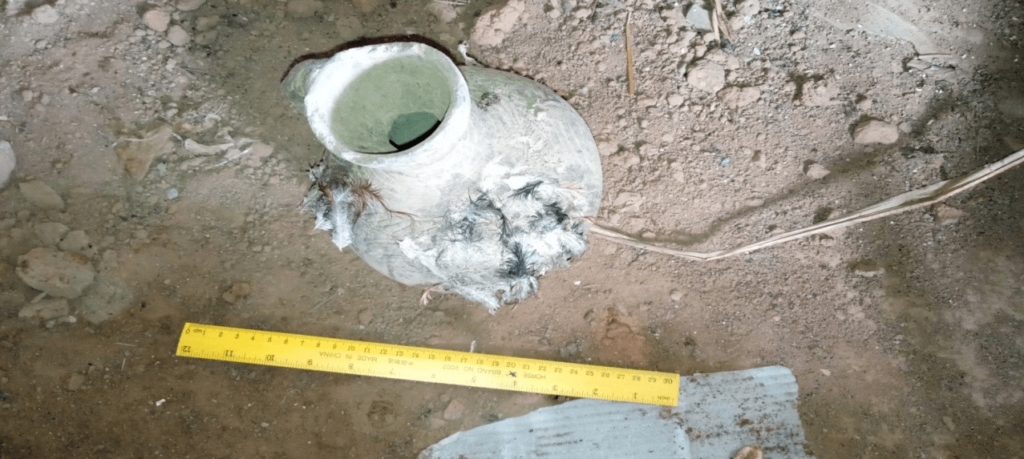
Dandong: The Dandong is a musical instrument that sometimes is played along with incantations. It is used as a musical instrument during festive period and it played using a short animal horn like cow. The Dandong is mostly used to play music during festive periods of the cult. The dandong is made from iron and it is heavy it is identified by the researcher to be similar to a gong both in appearance as well as in function. The Dandong is considered sacred by the cult and its members and as such it is kept in the ludas (Plate 9).
Plate 9. Dandong
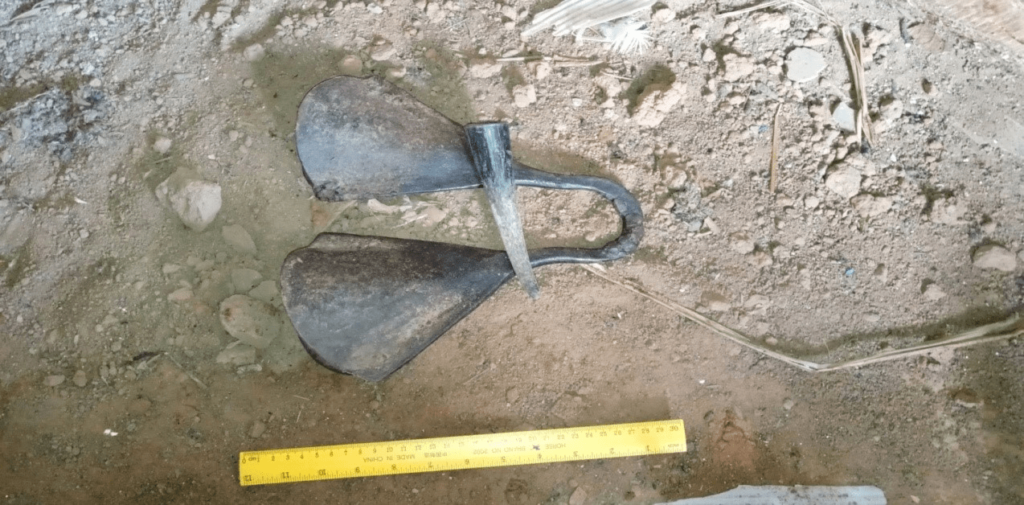
Kam kwamteng: This is the staff of authority of the cult, it is only held by the chief priest or the leader of the cult, the staff is made from two iron rods, the iron rods are tied together with ropes made from wood fibers and tied round the staff with chicken feathers attached to the staff. The staff is said to possess some magical powers and as such it is used by the chief priest to cast a spell, perform magic, and in performing some rituals and incantations. Due to the power the staff possesses it is not kept on the ground for long and as such, immediately it serves its purpose it is hung on the roof of the ludas (Plate 10).
Plate 10. Kam Kwamteng
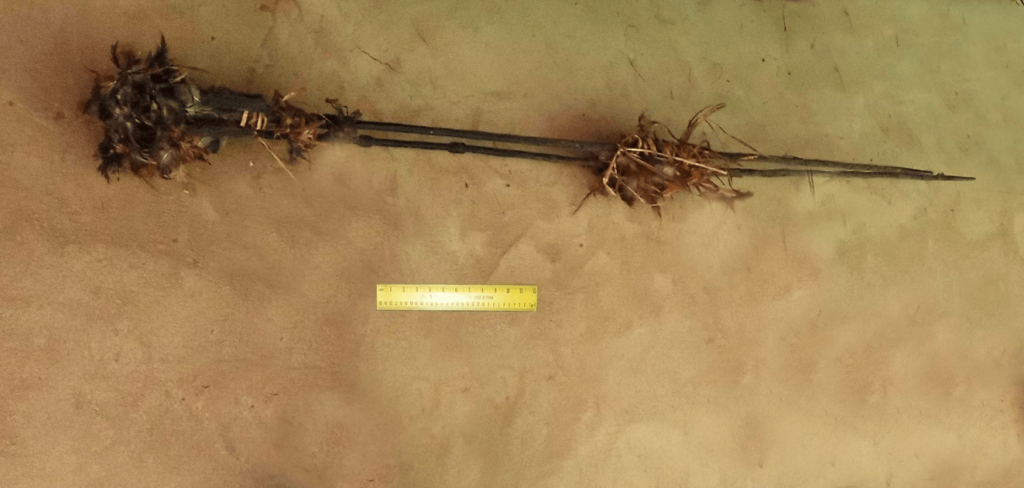
Sum Kwamteng: This a horn of an unidentified animal but can be described by the researcher to belong to the African Buffalo that is being cut and attached or tied together at the extreme to give it a shape that looks like the alphabet C. It is held with two hands used to drive witches and also used for cleansing, the sum Kwamteng can also be used to fight spiritual forces during festivity and also used during dance. The sum Kwamteng posses powers and can be used to perform certain rituals. Due to the power it possesses it cannot be kept on the ground because they believe allowing it to touch the ground cause the Sum Kwamteng to loose its potency and as such render it powerless which is why it is being hung through the rope on the ludas roof after it serves its purpose (Plate 11).
Plate 11. Sum Kwamteng
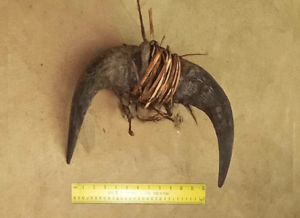
Tu Kwamteng: This is a calabash that is known as the bottle gourd. It has chicken feathers all over it. It is used to store medical herbs that are being used to cure certain diseases and ailments associated with adults. The Tu Kwamteng is also hung on the Ludas roof in order to maintain its potency as leaving it on the ground may cause it to loose it potency and effectiveness (Plate 12).
Plate 12. The Tu Kwamteng
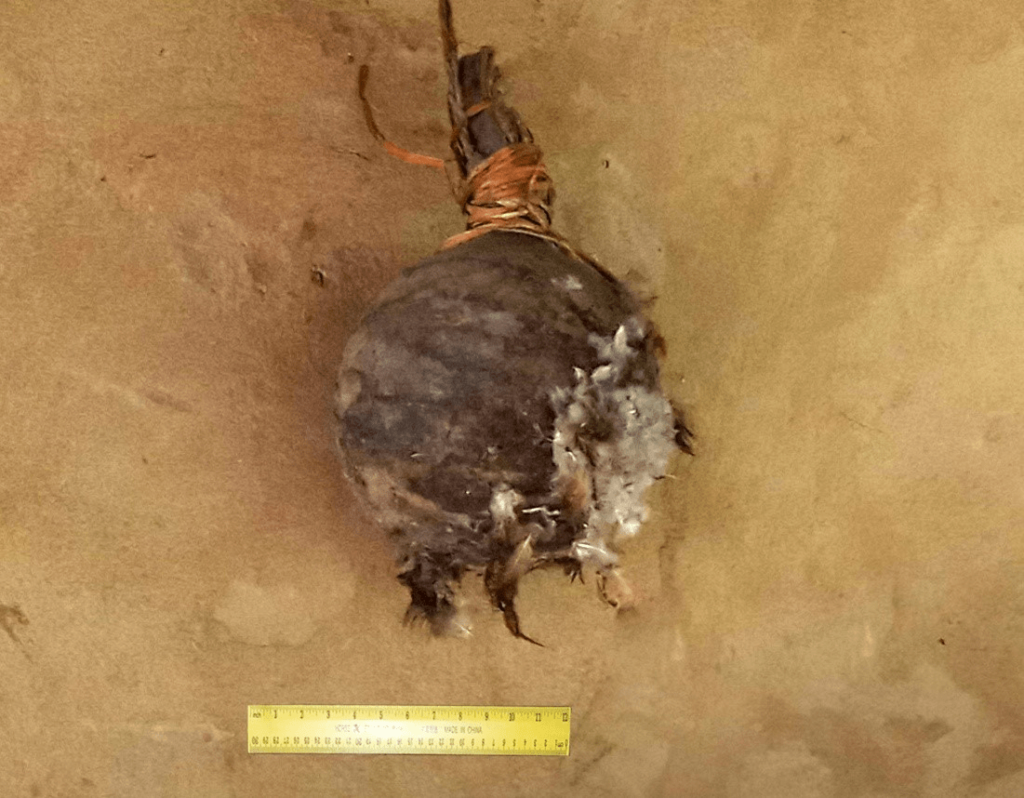
Members of Kwamteng during Bit-Goemai Festival
As earlier mention Kwamteng members are being taught some nice dance steps while in training in the jungle, it is this dance steps they display during cultural festivals as well as any cultural ceremony. This dance steps that is always accompanied with traditional music in their costume, the researcher described as the prehistoric traditional African style of dressing with a small fabric covering only the private part. During this public functions the members of the cult disguise themselves beyond recognition as they rob mud and ashes all over their body and cover their face with one hand as the hold and play musical instrument with the other hand. The dance is known as the Kwamteng dance (Plate 13).
Plate 13. The Kwamteng on Display at the Bit-Goemai Festival in Shendam, 2019
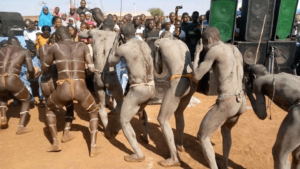
Relevance of Kwamteng to the Culture and Tradition of Goemai People of Demshin
Kwamteng has an organized religious system: Like in other Nigerian traditional societies, the mode of worship in Kwamteng cult it largely involves pouring of libations, concoctions, rituals and sacrifices. These sacrifices are usually requested by the chief priest from worshippers seeking one favor or the other. Currently, there are more youths involved in its worship than the old. It records an average of 20-25 individual visitations per month.
Evidence from this study helps debunk the notions of Eurocentric scholars who claim that African traditional religions are fetish, barbaric or primitive and filled with backwardness. This western religion has no doubt affected the authenticity of African religion and has eroded and jettisoned African belief systems, which Kwamteng is a part. The study brings to light the antiquity of African traditional religion and the practices around them that include certain rituals and traditions that binds on all members of the community and these traditions serve as the law of the land guiding human behaviors and some of the cultural practices are solutions to some of the problems of the society particularly on the knowledge of herbal medicine that is good for sustainable development as well-boost the local economy of the African people through their traditional religion.
Sustainable conflict management strategy: Kwamteng has a sustainable conflict management strategy as the cult tends to provide solutions to conflict related matters in Demshin community thereby ensuring peaceful coexistence among members of the community and promote unity between communities. Nigeria can harness phenomenal conflict management and dispute resolution strategies embedded in our rich traditional societies. These can be adopted, modified and deployed locally or regionally and be given constitutional backing.
Cultural heritage management: Kwamteng traditional secret cult has a wide range of taboos that include women cannot come close during initiation of a new member and during the burial rites of a deceased member, members of the community cannot fight in the presence of the member of Kwamteng and also a chief cannot be crown unless he join the cult among other taboos. These taboos, the researcher observed, are geared towards self-preservation and the sustainable conservation of the Goemai heritage properties. Like the UNESCO 2003 convention has admonished, such taboos and other self-preservation techniques of local communities must be incorporated in the wider spectrum of cultural heritage management efforts.
Kwamteng serves as the security and custodian of Goemai
cultural history: Kwamteng serves as one of the security forces and ideal protector of the land thereby protecting the community from both physical and spiritual attack which is important for state formation and development and again the cult also serves as the custodian of some aspect of Goemai culture and history which include Goemai culture and traditions, norms, beliefs and values among others, as through their activities the tends showcase most of the Goemai culture and heritage as one can consult them for reliable cultural history of the ancient Goemai.
Judicial roles: Kwamteng is a feared deity in these environs. It is renowned for swift and impartial conflict resolutions between parties, retrieving of stolen properties of members of the cult and that of the community and it also confiscates the properties of defaulters/offenders, including their corpses when they die. Swearing at Kwamteng’s shrine is serious business because death or grave sickness befalls any liar.
CONCLUSION
Finally, this paper has revealed new information on Kwamteng and from a culture-historical perspective. This study also contributes to existing knowledge about deities within the Goemai cultural sub-group of Goemailand, an area with many untapped academic potentials. The information that has emerged from this research, to an extent, has shown the contribution of ethnography to archaeology which in this case ethnography did not only contribute to the construction of the history of Kwamteng in Demshin and also to other aspects of the Demshin people’s culture but also help in the surveillance of the area for archaeological research. The research has shown that Kwamteng is an ancient tradition in the Goemai area and it played a very significant role in safeguarding an aspect of Goemai history and culture as well as cultural heritage. It can also be observed in the research that the cult obtains herbs and other substances and use them in curing certain ailments and diseases.
In addition, as evidence by iron implement which may be obtained from trade or contacts implies that the Demshin people were in contact with other societies at a period dating far into antiquity. In addition, the ancient Demshin settlement reflects an organized society with functional socio-religious leadership characterized by some level of gender roles especially in the ritual aspects. They also shared ritual responsibilities as reflected in the rituals associated with harvest of cultivated crops as this ritual involves families who had individual responsibilities for some of their rituals. Thus, the research shows how the Demshin people interacted with their natural environment by exploiting natural resources for their health and socio-religious challenges.
However, it must be pointed out that the present research is in a foundation stage as such it cannot draw any conclusive information.
INSTITUITIONAL BOARD PERMISSION
Yes.



















